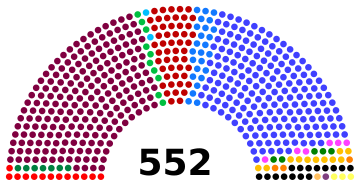National Assembly (Thermodolia)
National Assembly of Thermodolia Grœtha Æāeńú Thômthdólasć | |
|---|---|
| 44th Federal Parliament | |
| Type | |
| Type | Lower House of the Federal Parliament |
| History | |
| Founded | 12 October, 1898 |
| Preceded by | National Senate |
New session started | 10 August, 2020 |
| Leadership | |
President of the National Assembly | Jan Daesn, GT since 26 August, 2015 |
Prime Minister | Dan Riægh, GF since 15 January, 2021 |
Deputy Prime Minister | Lucy Sâva, LA since 15 January, 2021 |
Leader of the Opposition | Derak Gœs, GŒ since 15 January, 2021 |
| Structure | |
| Seats | 552 |
 | |
Political groups | Government: United Center Coalition (286) GF: 25 seats GT: 190 seats R: 6 seats TG: 15 seats LA: 50 seats Main Opposition: Left United Coalition (241) ŒA: 13 seats G: 7 seats GŒ: 210 seats GGP: 10 seats ČŒP: 2 seats
Opposition: Traditional Coalition (19) ČC: 11 seats F: 3 seats TČP: 1 seat ÆP: 1 seat ČGP: 3 seats Opposition: Non-Aligned (6) GS: 5 seats
Independent Politician: 1 seat
|
| Elections | |
| IRV (368 Seats)/SNTV (184 seats) | |
Last election | 20 July, 2020 |
Next election | 12 August, 2021 |
The National Assembly of Thermodolia is the lower house of the Federal Parliament of Thermodolia.
History
Power and Structure
Membership
Government
Political Parties
Elections
Elections for National Assembly occur every three years. All Citizens of the age eighteen and older, who are not currently serving a prison sentence, may vote for the representatives.
The entire 1,000 member National Assembly is elected by closed party-list proportional representation in a single nationwide district that covers all of Thermodolia. All seats are apportioned through the use of the largest remainder method using the hare quota. Prior to 2022 the National Assembly apportioned the seats via a system known as the Thermodolian Method.
This method apportioned seats using the precenatage of the votes that each party obtained in the election, the precenatage was counted up to the tenths place following the whole integer. The method had a threshold of .5%, any party that did not reach this threshold was not elected unless there where any seats remaining to hand out. If any seats where left to hand out after all parties which had made it above the threshold where apportioned, then those seats that remained would be handed out to the largest party or parties that did not meet the threshold unitl there where no more seats left.
The method was only used once with only one seat being left over after the other seats where apportioned. That seat was then given to Free Nôrgántha who had only gained .4% of the vote. After the 2021 election the method was changed to the current system with the threshold being dropped to .1%, the ammount needed to win a single seat.
Previously the National Assembly was elected by a combination of Instant-Runoff Voting and Single Non-Transferable Voting, pure Instant-Runoff Voting, and First Past The Post. Under the IRV/SNTV system two-thirds of the seats where elected by IRV with one-third being elected by SNTV in four member districts. In the last election before the switch to the current system (2020) 368 seats where IRV seats with 184 seats as the SNTV seats, this worked out to a total of 414 districts. These districts where apportioned to the provinces by population with each province getting at least one seat and one SNTV district being granted to all overseas voters.
Under the two other systems, IRV and FPTP, the 552 seats of the National Assembly where apportioned to the provinces by population with each province getting at least one seat and no seats for overseas voters.